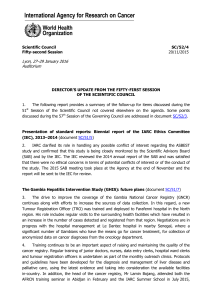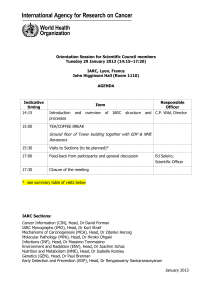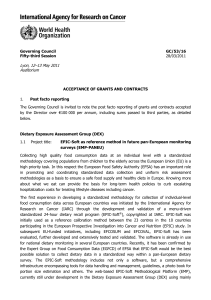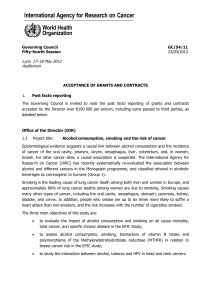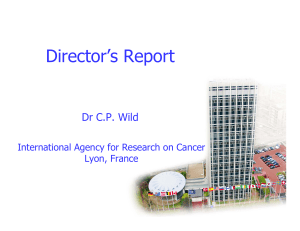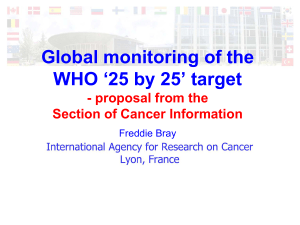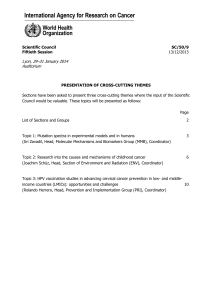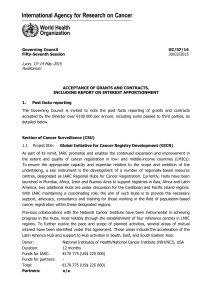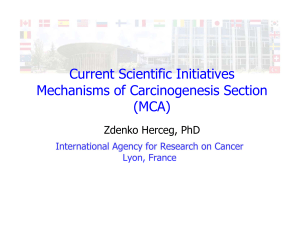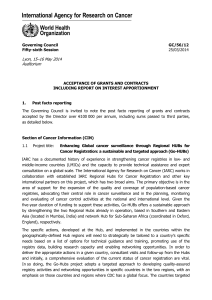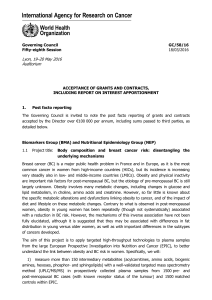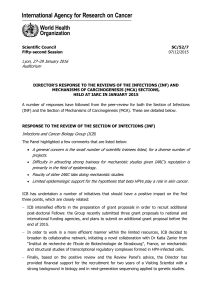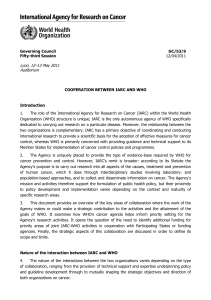Lyon, 28–30 January 2015 Auditorium
publicité
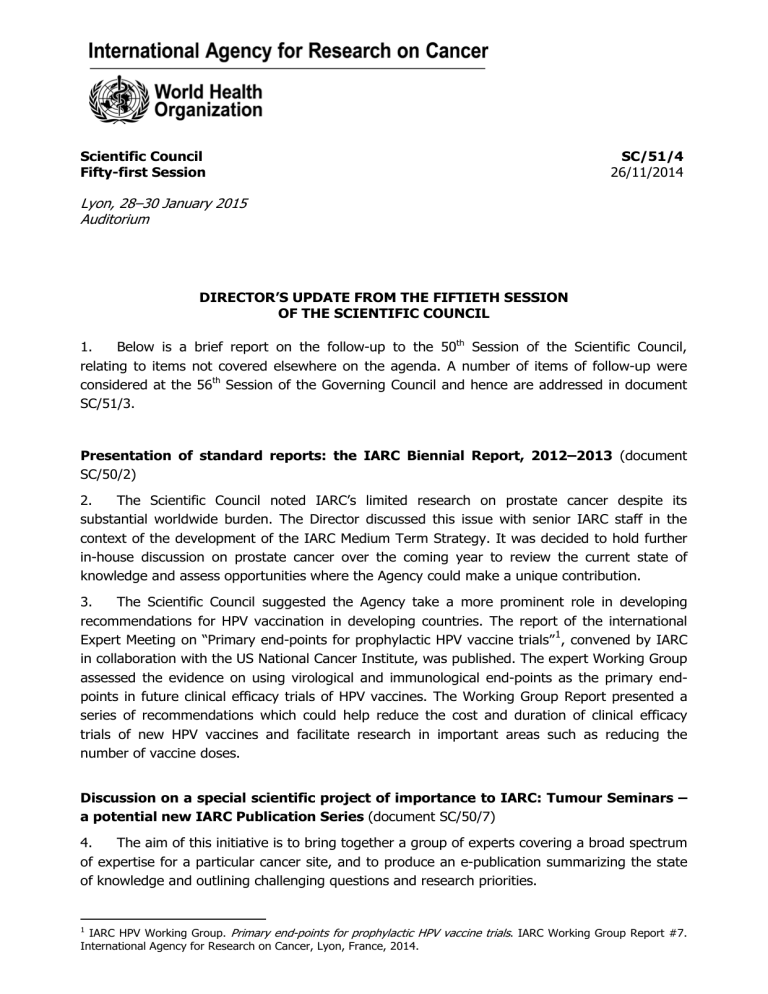
Scientific Council Fifty-first Session SC/51/4 26/11/2014 Lyon, 28–30 January 2015 Auditorium DIRECTOR’S UPDATE FROM THE FIFTIETH SESSION OF THE SCIENTIFIC COUNCIL 1. Below is a brief report on the follow-up to the 50th Session of the Scientific Council, relating to items not covered elsewhere on the agenda. A number of items of follow-up were considered at the 56th Session of the Governing Council and hence are addressed in document SC/51/3. Presentation of standard reports: the IARC Biennial Report, 2012–2013 (document SC/50/2) 2. The Scientific Council noted IARC’s limited research on prostate cancer despite its substantial worldwide burden. The Director discussed this issue with senior IARC staff in the context of the development of the IARC Medium Term Strategy. It was decided to hold further in-house discussion on prostate cancer over the coming year to review the current state of knowledge and assess opportunities where the Agency could make a unique contribution. 3. The Scientific Council suggested the Agency take a more prominent role in developing recommendations for HPV vaccination in developing countries. The report of the international 1 Expert Meeting on “Primary end-points for prophylactic HPV vaccine trials” , convened by IARC in collaboration with the US National Cancer Institute, was published. The expert Working Group assessed the evidence on using virological and immunological end-points as the primary endpoints in future clinical efficacy trials of HPV vaccines. The Working Group Report presented a series of recommendations which could help reduce the cost and duration of clinical efficacy trials of new HPV vaccines and facilitate research in important areas such as reducing the number of vaccine doses. Discussion on a special scientific project of importance to IARC: Tumour Seminars – a potential new IARC Publication Series (document SC/50/7) 4. The aim of this initiative is to bring together a group of experts covering a broad spectrum of expertise for a particular cancer site, and to produce an e-publication summarizing the state of knowledge and outlining challenging questions and research priorities. 1 IARC HPV Working Group. Primary end-points for prophylactic HPV vaccine trials. IARC Working Group Report #7. International Agency for Research on Cancer, Lyon, France, 2014. Scientific Council Director’s update from the 50th Scientific Council SC/51/4 Page 2 5. It was decided to hold a meeting on renal cancer in the first instance, serving as a pilot exercise for decisions on future planning. The latter meeting was initially planned for November 2014 but had to be postponed to April 2015 due to the unavailability of several key participants. Discussion on “Study of chrysotile asbestos in Russia” (SC/50/12) 6. The Scientific Council recognized this study addresses important unresolved scientific questions, and highlighted a number of unique qualities of the study design. It also acknowledged potential risks to the scientific integrity of the study and strongly advised IARC to withdraw from the study if its design, conduct or analysis was compromised. 7. The Director and IARC Principal Investigators continue to proactively monitor the conduct of the study and to respond to advice from the Scientific Advisory Board (SAB) and the IARC Ethics Committee (IEC) who regularly review this study. The SAB met on 8 October 2014 and the IEC reviewed this study on 19 November 2014. 8. Overall, the scientific progress made on the project was appreciated, with data entry of eligible cohort members to be completed by the end of 2014, with a focus on entering the past occupational work histories (1950s to 1975) from archive data in the upcoming year. The first test linkages for outcome data were completed. The SAB endorses the efforts of IARC to have all procedures ready for the main follow-up when the full cohort ascertainment has been completed, including checking of duplicates and eligibility checks based on the work histories. Presentation of cross-cutting themes and discussion (document SC/50/9) Topic 1: Mutation spectra in experimental models and in humans (MutSpec) 9. The purpose of this project is to develop an experimental in-vitro modelling system to generate novel mechanistic insights into the effects of specific cancer agents, and to identify genome-wide mutation patterns linked to specific exposures that could be used to support reliable carcinogen identification, and to verify exposure:disease associations in epidemiological studies. 10. A first collaborative study was published (Olivier M et al., Sci Rep 2014) and new studies are underway on aflatoxin B1, 1,2-dichloropropane and dichloromethane in experimental systems and primary tumours, involving new partners (National Cancer Centre/Duke-NUS Graduate Medical School, Singapore, the US National Toxicological Program). Bioinformatics tools have been designed both for mutational signature analysis, successfully applied to a study on environmental exposure-associated cancers (Jelakovic B. et al., Int J Canc 2014), and to permit semi-automated prioritization in selection of compounds based on their likely mutagenicity/carcinogenicity. Future testing priorities involve organochlorine (OC), organophosphate (OP) pesticides and selected dietary and tobacco carcinogens. SC/51/4 Page 3 Scientific Council Director’s update from 50th Session of the Scientific Council Topic 2: Research into the causes and mechanisms of childhood cancer 11. The purpose of this project is to perform metabolomic and epigenomic profiling of samples collected at birth in large international birth cohorts in order to explore potential links between prenatal exposures to known environmental risk factors, early effect markers and childhood cancer outcomes. 12. IARC continues to collect and publish the most authoritative data on childhood cancer incidence and survival. The central Data Coordination Center of the Childhood Leukemia International Consortium (CLIC) has finally been established at IARC, so that further pooling projects can start to be facilitated through the Agency. All activities however, from descriptive epidemiology (ACCIS), to the epidemiological consortia of CLIC and of the Global Acute Leukaemia Network (GALnet), and the epidemiological genetics-orientated consortia (work within the International Childhood Cancer Cohort Consortium (I4C), International Study of Embryonal Tumours (ISET)) seek further funding for improved continuation, with pending applications. Topic 3: HPV vaccination studies in advancing cervical cancer prevention in low- and middle-income countries (LMICs): opportunities and challenges 13. The objectives of this project are to develop models of transmission of HPV infection coupled with models of cervical cancer natural history in order to predict the long-term impact of interventions such as the introduction of HPV vaccination or of cervical cancer screening. 14. The IARC HPV-transmission-model has been used to assess the implications of a transition from traditional to permissive sexual behaviour in a population (paper in preparation). The transition to a permissive behaviour entailed an approximately 2.5-fold increase in HPV prevalence, profoundly modified the HPV prevalence age distribution and revealed a particularly favourable, time-limited window for a highly effective introduction of HPV vaccination in traditional populations even with initial sub-optimal coverage. National and international agencies may seize this special opportunity for vaccination with adequate political commitment, planning, and fund-raising.







